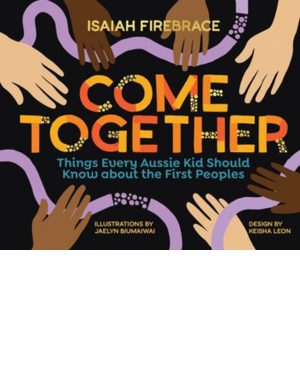
Come Together: Years 3-4 English and HASS
Exploring the 2023 CBCA Short List: Information Books
All curriculum links in this unit use the latest national and state curriculums. Use this guide to compare codes across AC versions.
 Download and print this unit: AC Version | NSW Version | VIC Version
Download and print this unit: AC Version | NSW Version | VIC Version
Author & Illustrator: Isaiah Firebrace Illustrator: Jaelyn Biumaiwai
Designer: Keisha Leon Publisher: Hardie Grant
Unit writer: Karen Rogers
Synopsis (from CBCA judges' notes): This strikingly gorgeous book by pop artist Isaiah Firebrace introduces the basics of First Nations customs, beliefs and history. From the attractive cover showing hands coming together, and simple endpapers, the reader is drawn into learning about the oldest continuous civilization on earth. Isaiah shares important insight into aspects of Indigenous culture that all people, not just the young, should know – from caring for Country and Dreaming stories to the importance of Elders and even the Indigenous origins of AFL. Language is easily accessible to the younger reader, and while it does not delve into some of the more complex aspects of First Peoples culture, there is sufficient information to provide an overview and the knowledge to inspire the reader to look further. The accompanying colourful illustrations by Jaelyn Biumaiwai dominate each double-page spread, enhancing the written text and having maximum impact. This is a powerful book that would appeal to a wide ranging audience and holds significant enduring value.
Themes: respect, culture, connection, understanding, unity
Year levels/Learning Areas: Australian Curriculum: English, Year 3 and 4; HASS (History; Geography; Civics & Citizenship), Year 3 and 4
General capabilities: Intercultural Understanding, Level 3
Cross-curricular priorities: Aboriginal and Torres Strait Islander Histories and Cultures; Sustainability
Why use this book? In this book the author, Isaiah Firebrace, draws on his own experience of education in Australia to create an argument for learning about our First Peoples. Using a first-person perspective he speaks directly to his target audience of ‘Aussie kids’. The topics chosen for inclusion in the book are easily relatable for primary school students and the language used is both personal and informative. In the classroom the book can serve as a springboard for further exploration of Indigenous cultures and histories and as a mentor text for informative writing as well as the use of multimodal design elements.
Focus passages: The following pages have been selected for closer analysis throughout the teaching unit:
- Pages 2-3 – Author's purpose; language to persuade
- Pages 34-35 – Text structure; illustrations; layout; creating meaning